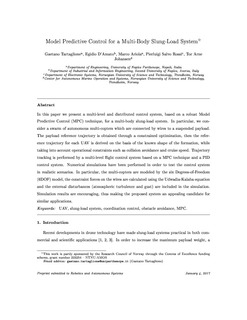| dc.contributor.author | Tartaglione, Gaetano | |
| dc.contributor.author | D'Amato, Egidio | |
| dc.contributor.author | Ariola, Marco | |
| dc.contributor.author | Salvo Rossi, Pierluigi | |
| dc.contributor.author | Johansen, Tor Arne | |
| dc.date.accessioned | 2017-12-12T15:05:03Z | |
| dc.date.available | 2017-12-12T15:05:03Z | |
| dc.date.created | 2017-10-18T10:36:29Z | |
| dc.date.issued | 2017 | |
| dc.identifier.citation | Robotics and Autonomous Systems. 2017, 92 1-11. | nb_NO |
| dc.identifier.issn | 0921-8890 | |
| dc.identifier.uri | http://hdl.handle.net/11250/2470898 | |
| dc.description.abstract | In this paper we present a multi-level and distributed control system, based on a robust Model Predictive Control (MPC) technique, for a multi-body slung-load system. In particular, we consider a swarm of autonomous multi-copters which are connected by wires to a suspended payload. The payload reference trajectory is obtained through a constrained optimization, then the reference trajectory for each UAV is derived on the basis of the known shape of the formation, while taking into account operational constraints such as collision avoidance and cruise speed. Trajectory tracking is performed by a multi-level flight control system based on a MPC technique and a PID control system. Numerical simulations have been performed in order to test the control system in realistic scenarios. In particular, the multi-copters are modeled by the six Degrees-of-Freedom (6DOF) model, the constraint forces on the wires are calculated using the Udwadia–Kalaba equation and the external disturbances (atmospheric turbulence and gust) are included in the simulation. Simulation results are encouraging, thus making the proposed system an appealing candidate for similar applications. | nb_NO |
| dc.language.iso | eng | nb_NO |
| dc.publisher | Elsevier | nb_NO |
| dc.rights | Attribution-NonCommercial-NoDerivatives 4.0 Internasjonal | * |
| dc.rights.uri | http://creativecommons.org/licenses/by-nc-nd/4.0/deed.no | * |
| dc.title | Model predictive control for a multi-body slung-load system | nb_NO |
| dc.type | Journal article | nb_NO |
| dc.type | Peer reviewed | nb_NO |
| dc.description.version | acceptedVersion | nb_NO |
| dc.source.pagenumber | 1-11 | nb_NO |
| dc.source.volume | 92 | nb_NO |
| dc.source.journal | Robotics and Autonomous Systems | nb_NO |
| dc.identifier.doi | 10.1016/j.robot.2017.02.007 | |
| dc.identifier.cristin | 1505471 | |
| dc.relation.project | Norges forskningsråd: 223254 | nb_NO |
| dc.description.localcode | © 2017. This is the authors’ accepted and refereed manuscript to the article. Locked until 24.2.2019 due to copyright restrictions. This manuscript version is made available under the CC-BY-NC-ND 4.0 license http://creativecommons.org/licenses/by-nc-nd/4.0/ | nb_NO |
| cristin.unitcode | 194,63,35,0 | |
| cristin.unitcode | 194,63,25,0 | |
| cristin.unitname | Institutt for elektroniske systemer | |
| cristin.unitname | Institutt for teknisk kybernetikk | |
| cristin.ispublished | true | |
| cristin.fulltext | postprint | |
| cristin.qualitycode | 1 | |

